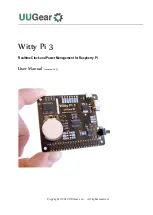
Tolomatic • URL: http://www.tolomatic.com • Email: [email protected] • Fax: (763) 478-8080 • Toll Free: 1-800-328-2174
2 – Instructions
MXP16P
Parts Sheet #8100-4115_05_MXP16P_ps
CYLINDER DISASSEMBLY INSTRUCTIONS
Begin with a clean work area. Make sure all replacement parts are avail-
able and have no visual damage or defects. The following tools and
materials are recommended for proper disassembly and assembly. (Exact
wrench sizes will vary depending on cylinder size.)
• Allen wrench set (English and Metric)
• Torx wrench set
• Small straight edge screwdriver
• Socket wrench & socket set
• Needle nose pliers
• Tin snips
• Razor Blade
• RheoGel TEK664 grease
For best actuator performance it is recommended that the following
instructions be read and followed carefully.
1. REMOVE BAND CYLINDER FROM MACHINERY
Remove all mounting hardware and air connections, if present, from
the Cylinder Heads (10) and/or Carrier (33).
2. REMOVE CARRIER FROM CYLINDER
Remove Screws (34) from Carrier (33). Slowly lift up the Carrier (33)
and remove it from the cylinder.
CAUTION:
Contaminating the Bearing Block (28b) will hinder the
operation of the Band Cylinder. Do not remove the Bearing Blocks
(28b) from the Bearing Rail (28a).
Remove Screws (31) and Adjustment Plates (29) from Piston
Bracket (1).
3. REMOVE BEARING RAIL (OPTIONAL)
The MX Bearing System is designed to provide maximum life. Should
the Bearing Blocks (28b) need replacement, the Bearing Rail (28a)
will need to be replaced as well. Bearing Blocks (28b) and Bearing
Rail (28a) must remain together. If the cylinder stroke requires two or
more Bearing Rails to be mounted, the cylinder will need to be sent
to the factory. It is critical that the two (or more) Bearing Rails are
aligned properly. This requires special fixtures and cannot be done in
the field. To remove both Bearing Blocks and Bearing Rail, slide each
Bearing Block to the furthest end of the Bearing Rail. Remove the
Screws (30) from the other end of the Bearing Rail. Move Bearing
Blocks back to the other end of the Bearing Rail and remove remain-
ing Screws.
4. REMOVE BAND CLAMPS
Loosen Set Screws (18) on Dust Band Clamp (13). Remove Screws
(9) from Cylinder Heads (10). Remove Seal Band Clamp (12) from
between Dust Band (20) and Seal Band (19). Repeat for other
Cylinder Head.
5. REMOVE DUST BAND
Remove End Caps (5) from both ends of the Piston Bracket (1) by
removing Screws (23). To remove Dust Band (20), lift one end and
pull the Band through the Piston Bracket. The Band is magnetically
retained so some resistance will be present when removing.
6. REMOVE HEADS
Remove the four Head Screws (24) to free each Cylinder Head (10).
Remove each Head by rocking it up and down until the Head is free
from the Cylinder Tube (26).
DO NOT TWIST!
Remove the O-ring
(14) from both Heads with a small straight edge screwdriver.
7. REMOVE SEAL BAND
CAUTION:
Sealing Band edges are sharp. Grasp the top and bottom
of the Band when removing, not the edges
.
Slide Piston Bracket (1) out of the Cylinder Tube (26). Remove the
Sealing Band (19) through the slot in the Tube.
8. DISASSEMBLE PISTON BRACKET
Remove Wipers (7) from the Piston Bracket (1). With a small straight
edge screwdriver, remove the U-Cups (3) from both Pistons (2).
Remove the Cushion Seal (4) from each Piston. Remove the Pistons
(2) by inserting a small allen wrench into the holes on each side of
Piston Bracket (1) to disengage the Pistons. With a small screwdriver,
remove the Band Ramps (6) and the Plastic Bearings (8) by disengag-
ing the side retaining tabs for each. Keep the Piston Bracket (1) and
the two Pistons (2) for reassembly.
22
25
6
9
18
13
15
16
12
24
17
10
14
5
11
4
3
2
8
7
1
20
19
21
23
26
28a
30
29
31
28b
34
33
Drawing repeated for reference























